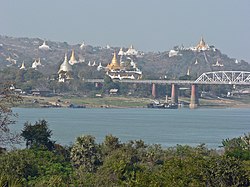Sagaing
| စစ်ကိုင်း Sagaing |
||
|---|---|---|
|
|
||
| Coordinates | 21 ° 54 ′ N , 95 ° 59 ′ E | |
| Basic data | ||
| Country | Myanmar | |
| Sagaing region | ||
| ISO 3166-2 | MM-01 | |
| Residents | 300,000 | |
|
Bridge to Sagaing
|
||
Sagaing ( Burmese စစ်ကိုင်း , BGN / PCGN : sitkaing) is the capital of the Sagaing region of the same name in Myanmar (Burma). It is one of the Buddhist centers of Myanmar and is grouped around Sagaing Hill . More than 600 stupas and monasteries and 100 meditation centers can be found here, more than 6000 monks and nuns live here and attract tourists from all over the world. The population is around 300,000.
Sagaing is located about 20 km southwest of Mandalay near the former royal city of Ava on the Irrawaddy . The 700 m long Ava Bridge, built by the British with 16 large arches, crosses the Irawadi and connects Mandalay with Sagaing. Until 1998 the bridge was the only bridge that crossed the 2170 km long Irrawaddy.
history
Sagaing is named after a species of tree that hangs over the river. It became the capital of an independent Shan kingdom around 1315 after the decline of Bagan's central Burma into chaos. A short time later, however, in 1364, Thado Minbya , the founder's grandson, moved the capital to Ava. For four years, from 1760 to 1764, Sagaing was once again the capital of a Burmese empire.
Culture and sights
- Aungmyelawka (Eindawya) Pagoda, built in 1783 by the later King Bodawpaya , imitates the Shwezigon Pagoda of Nyaung U (Bagan).
- Tilawkaguru Cave: a cave temple with wall paintings from 1672 that were damaged by a large fire 80 years ago, but are still worth seeing
- Ngadatkyi Pagoda
- Kaunghmudaw Pagoda (also known by the Pali name Rajamanicula), about 10 km west of Sagaing. It is the largest of the pagodas, 46 m high, and was built after the model of the Mahaceti-Stipa in Sri Lanka in 1636 in honor of Sagaing's appointment as capital. Around the pagoda there are 812 stone pillars in which oil lamps were kept. There are pictures of Nats in 120 niches . The history of the building of the temple is described on a three meter high marble stone
- Datpaungzu Pagoda
- U Min Thonze Pagoda, the pagoda of the 30 caves . Forty-five larger than life statues of Buddha clad in gold stand in a colonnade that has the outline of a crescent moon. The walls are decorated with glass mosaics, the floor is laid out with geometric tile patterns.
- Min Kyaukse Pagoda
- Lawkakmankin Pagoda
- Mipaukkyi Pagoda
- Tupayon Pagoda, built in 1444, was partially destroyed in the severe earthquake of 1838
- Hsinmyashin Pagoda, Pagoda of the Many Elephants , named after the elephant statues at the entrances, built in 1429
- Sun U Ponnya Shin-Paya, built in 1312. Bronze hares and frogs symbolize earlier incarnations of the Buddha and serve as collection boxes.
- Pa-Ba-Kyaung Monastery
- Ahsaykhan fort
- Thabyedan Fort
- Singyone Fort













